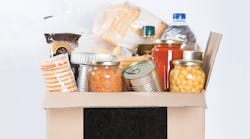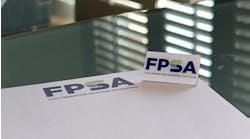Probably since the first grocery store, a Piggly Wiggly, opened in Memphis in 1916, food and beverage processors have sought a way to cut out that middleman and sell their products directly to the consuming public.
There’s been little progress in 102 years. Does the arrival of the internet change things? That’s one question ... the other being just how much grocery shopping the coming generations of consumers will do online.
The digital age is definitely here, and so is e-commerce, although clearly less so in the food and beverage industry than in just about any other. About 35 percent of all computer hardware is bought online; office equipment and supplies is next at 28 percent of total category sales, and general electronics comes in at 27 percent. Online food sales account for just 2.6 percent of grocery sales today, which, nevertheless, equates to about $25 billion, according to Kantar Consulting (kantarconsulting.com).
American online grocery shopping also is lagging some other parts of the world. Douglas Straton, Hershey’s chief digital commerce officer, told financial analysts in August online shopping globally is 5.8 percent, including 5.6 percent in Europe and 7.3 percent in Asia – most of that in China. “A lot of these countries, especially in Europe, started a lot earlier on than the U.S.,” he said. “In the U.K. ... Tesco launched online groceries 18 years ago.”
Kantar estimates the U.S. penetration should increase to 6.5 percent by 2023, or $74 billion. Not gangbusters in the trillion-dollar big picture, but not insignificant, either; certainly something that should be looked into.
Around a quarter of American households currently buy some groceries online each month, up from 19 percent in 2014, and more than 70 percent will engage with online food shopping within 10 years, according to “The Digitally Engaged Food Shopper” report from Food Marketing Institute and Nielsen. It also found that of those who will buy digitally, 60 percent expect to spend about a quarter of their food dollars online in 10 years.
“This is without a doubt the greatest retail revolution we’ve seen over the last 50 years,” says John Carroll, Coca-Cola’s vice president and general manager of e-commerce for North America. “The brick-and-mortar world and the online world are merging. Mass retailers are buying smaller online companies, and online retailers are developing an offline presence. And it’s all being driven by how and where people are shopping.”
He apparently was referring to Walmart buying Jet.com and PetSmart buying Chewy.com, in the former example, and Amazon buying Whole Foods in the latter. But what has Coca-Cola been doing about the greatest retail revolution in the past 50 years? We’ll get to that in a few paragraphs.
In every presentation to financial analysts, the heads of the public food and beverage companies tout their efforts on the internet. While there have been valiant efforts and a few interesting case studies, no company can claim true success just yet or to have figured it out.
E-commerce to all of the big companies has become another major client worthy of its own vice president-level account manager – like the ones assigned to Walmart or Kroger – with most of his or her time spent talking to Amazon, but with one eye on other possibilities.
One of those other possibilities is direct-to-consumer sales. After all, food and beverage companies already marketing their products to consumers. “It’s definitely possible for food and beverage processors to sell directly to consumer, but they need to be realistic about how large that business can be,” warns Tory Gundelach, vice president of retail insights at Kantar Consulting.
“When a supplier sells directly to the consumer, the consumer loses the benefit of being able to purchase multiple brands in one cart – which is what a retailer provides,” she continues. “Selling directly to consumers would work best with extremely brand-loyal shoppers who only want a single brand or on higher-ticket purchases where purchasing a single item feels natural.”
What should their strategy be?
“First, a brand must determine what they are trying to accomplish by selling direct to consumers,” says Gundelach. “Is the goal to expand the brand reach, generate brand excitement, increase profit margins, build brand loyalty? The objective should guide the go-to-market strategy.
“Second, to compete in this space also requires a commitment to invest adequate resources to build out and keep updated a platform to sell directly to consumers,” she continues. “From a consumer standpoint, the key is to give shoppers a reason to buy direct – better prices, more variety, exclusive products, customizable product, etc. – but of course this must to be balanced against the needs of key retailer partners.”
Do you know of any brand success stories?
“Considering online [grocery shopping] is still newer to most consumers, purchasing grocery items online direct from a manufacturer is just in its infancy,” Gundelach concludes. “Based on that, I would say it is too early to call anyone a ‘success,’ but there is lots of promising experimenting happening with brands right now.”
Such as…
Coca-Cola Co.
Coca-Cola’s e-commerce strategy “entails working with retail and restaurant customers to find ways to sell more beverages in more buying occasions,” the company says. “It includes building e-commerce capabilities across the company and its network of bottling partners – from digital marketing to supply chain – to grow in today’s technology-driven omni-shopping landscape.”
A Coca-Cola report on the subject noted “six ways Coca-Cola is embracing the e-commerce revolution”:
- Partnering with Amazon Echo and other smart speakers to attach its beverages to voice-activated orders.
- Making Coca-Cola brands “pop” on the digital shelf. “For years, Coke has used in-store merchandising to drive impulse purchases as shoppers approach the beverage aisle. The company is applying the same creative rigor online by using high-resolution photos, inspirational copy and targeted marketing to inspire clicks.”
- Capitalizing on the food delivery occasion – partnering with restaurant delivery services like Uber Eats and DoorDash to find ways to add beverages to food orders, and with meal-kit delivery service Chef’d to curate Coke beverages with menu items.
- Click-and-collect: Tacking beverages onto online grocery orders.
- Direct-to-consumer: “For the first time in Coke’s more than 100-year history, bottlers are delivering select brands [products like Tab, Fresca and Mexican Coke] directly to consumers’ homes via a pilot called eFulfillment.”
- Building emerging brands: The company’s Venturing & Emerging Brands incubator is looking into how e-commerce can build smaller brands online.
Hershey
“For Hershey, search is the new shelf,” CEO Michele Buck was quoted in a European journal. In a presentation to financial analysts in August, she emphasized, “We know in this space we need to win in search. Winning in search is everything.”
“There’s no difference between digital and physical retail,” Hershey says on its website. “Digital and physical retail are complementary components of a total commerce approach.”
Straton, whom we cited earlier, told those same financial analysts to expect sales from e-commerce to account for “mid-single-digits in the next five years or so.”
Hershey created a 15-page PDF, apparently aimed at its retail partners, titled “The Power of Search in a Shopper’s World.” The report “boldly frames the word ‘search’ in the context of modern retail and gives you ideas on how to build an engaging total commerce ecosystem,” it explains.
“Building a search and engagement strategy with these four components is critical to creating an experience ecosystem that puts consumers front and center and wins in a total commerce world,” it says. The four components: content, connections, community and conversion. In the booklet, Hershey introduces a nine-member digital team that names Straton first and includes Todd Tillemans, Hershey’s U.S. president.
Among the booklet’s aphorisms: “Digital is the first shelf and search is the new strike zone” – attributed to Straton. And “Community results when the stage is set for shoppers to create shareable moments that support their narratives. In these moments, the shoppers – not the stories or the products – become the heroes” – attributed to Suzanne Jones, vice president of The Hershey Experience (whatever that is – we searched for that term on Hershey’s website but couldn’t find it).
General Mills
Big G says its e-commerce business grew 50 percent in fiscal 2018 (which ended May 27), and growth is expected to continue into fiscal 2019. Now, a lot of that bump came with the addition of Blue Buffalo, which sold a lot of pet food online. Nevertheless, General Mills expects to generate $1 billion in sales from e-commerce by fiscal 2020.
General Mills tested geo-targeting technology for Haagen-Dazs ice cream delivery last month in London, using Facebook Messenger to allow customers to place an order while tracking their locations via mobile browser. “When orders are being prepared for delivery, product is placed in portable freezer bags for the delivery teams to take to the consumer, ensuring the ice cream arrives at its best,” Samuel Horner, Haagen-Dazs U.K. senior brand manager, told a European journal.
Danone North America
The Vega brand of athlete-quality bars was acquired along with last year’s purchase of WhiteWave Foods. The company reports it’s doing some direct-to-consumer e-commerce with that brand and looking at the results to consider doing direct sales for other products.
“The question for us at this point is how to best organize our selling and marketing teams to do so, and that is a work in progress,” says a source at the company.
PepsiCo
“We think of e-commerce … [as] the Amazons of the world, and then the grocery click-and-collect,” Al Carey, CEO of PepsiCo North America, said at last February’s Consumer Analysts Group of New York (CAGNY) Conference. “Some parts of our portfolio play better than others in e-commerce. It’s not a material share of the business yet, but it is an extremely fast-growing part and we feel very grounded in how we are doing well in it.”
“We brought a lot of people from outside PepsiCo; we knew we didn’t understand the space,” Vivek Sankaran, president and COO of Frito-Lay North America, said at the same CAGNY meeting. “It’s not so much the physical side of it, it’s really about how do you win the screen, and that’s the skill set we didn’t have. So we have a bunch of people [and] that’s all they think about.”
Campbell Soup
Campbell Soup Co.’s digital strategy is a little up in the air, as the company undergoes a reorganization that will shrink it considerably. Former CEO Denise Morrison spoke often about e-commerce and food delivery … maybe that’s why she’s no longer CEO.
“Picture your pantry replenishing itself when you’re running low on broth or salad dressing. Of course, we’ll want those refills to be Swanson broth and Bolthouse Farms [dressings],” she told the CEO Club of Boston College, her alma mater, in 2017. “But regardless of brand, artificial intelligence, virtual reality and other emerging technologies may soon meet your needs automatically.”
Kellogg
Kellogg Co.’s Bear Naked brand has a channel on its website where visitors can create their own granola “with over 50 chef-inspired ingredients,” the opening page says. “Then, blend them with the help of our good friend IBM Chef Watson to create the perfect tasting granola. We’ve got everything from jalapenos to pomegranate arils, so go wild!”
After creating your blend, you get to name it and choose one of five bears to be pictured on your canister. My 11-oz. concoction cost $9.99 – postage was free.


